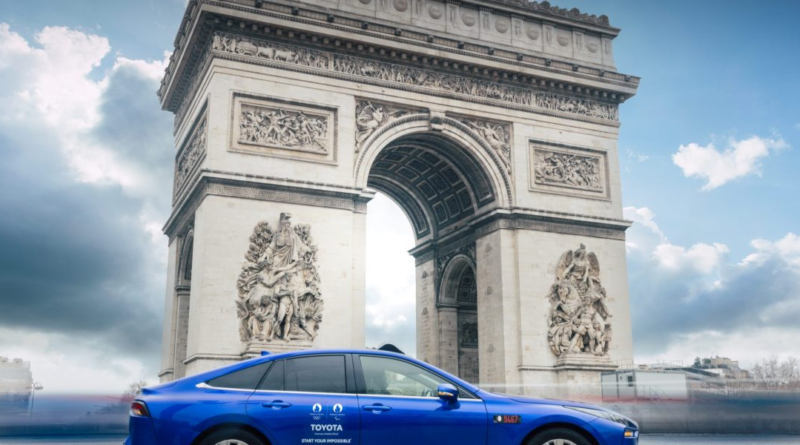With governments still gushing over hydrogen, why have 120 scientists objected to 500 hydrogen-powered Toyotas at the Paris Olympics?
Hydrogen fuel cell cars like the Mirai fulfill the sustainability goal of having zero CO2 tailpipe emissions, and they can be refueled in minutes. So, what exactly is the problem?
€2,200,000,000
The amount the EU has invested into the hydrogen industry in the spring of 2024.
The letter of complaint is the latest salvo in a heated debate that is almost as fractious as the American election. On the one hand, hydrogen supporters claim their favorite fuel is the natural decarbonized energy source of the future, with a similar ecosystem to combustion engines and short refueling times.
The EU seems to agree, having invested €2.2 billion worth of funding in the spring of 2024 alone. On the other hand, battery-electric vehicles are already selling in large numbers, the technology is improving and infrastructure growing. They are here now rather than a hope for the future.
The Toyota Mirai is the biggest-selling hydrogen fuel cell car, but it still only sold about 22,000 units globally by the end of 2022. There were only 2,737 Mirais sold in 2023, and just 245 in the first half of 2024. Compare that to the bestselling EV globally (and the bestselling car of any fuel type in 2023), the Tesla Model Y, which shifted 1.2 million units in 2023.
In the U.S., Toyota is facing a class action suit from a group of consumers who claim they were mis-sold the Mirai under the false pretense that hydrogen would be readily available.
2,737 vs. 1,200,000
The number of Toyota Mirais sold vs. Tesla Model Y’s in 2023.
In fact, the number of hydrogen fueling stations has been going backwards, with Shell pulling out of the business entirely in California, generally considered the most hydrogen-friendly region in the world.
When Shell announced this move, the company cited difficulties obtaining hydrogen for its pumps. It’s a familiar story elsewhere. France only has five hydrogen pumps for the whole country, and just two in Paris, which does beg the question where the cars serving the Olympics are being refueled.

Stanislav Kogiku—SOPA Images/LightRocket/Getty Images
In contrast, the battery EV charging network continues to expand, with over 120,000 public charge points in France at the end of January, for example.
France only has five hydrogen pumps for the whole country, and just two in Paris, which does beg the question where the cars serving the Olympics are being refueled.
Using the Toyota Mirai is supposed to be part of how the Paris Olympics becomes the greenest ever, halving its emissions compared to previous games. The Mirai is still an electric car, driven by an electric motor, but its primary energy source is a hydrogen fuel cell.
This technology combines hydrogen gas stored in a high-pressure tank with oxygen taken from the air in a process that generates electrical power. The only side product is water, which is expelled from the vehicle into the atmosphere. No CO2 is therefore emitted.
However, to be fully emissions-free, a hydrogen fuel cell vehicle like the Mirai needs to use “green” hydrogen. This means the hydrogen must be generated by using electricity from a zero-emission energy source, preferably renewables. The electrical energy is used to electrolyze water, separating it into its constituent hydrogen and oxygen. The hydrogen is then collected for use as a fuel.
So is hydrogen really green?
This is where the controversy begins with hydrogen’s employment for personal transportation, and indeed for every other application.
Very little of the hydrogen currently available globally is green. In fact, only about 1% is. The rest is generated from fossil fuels, usually via “steam reforming” of methane gas. This is called “grey” hydrogen and has significant CO2 emissions during the production process. The resultant CO2 can be captured and stored to make “blue” hydrogen, but that technology isn’t proven, and blue hydrogen is even less common than green.
Very little of the hydrogen currently available globally is green. In fact, only about 1% is.
If a hydrogen fuel cell car is powered by grey hydrogen, it’s not really a sustainable form of transport. Theoretically, it could be zero carbon like batteries, if green hydrogen production ramps up. But that’s a big “if”, and there are other caveats even when the hydrogen is green.
The secondary problem with hydrogen comes from the fact that using hydrogen as an energy carrier for an electric car like the Mirai is very inefficient. A lot of energy is lost from the process of electrolyzing hydrogen from water using electricity, transporting it to the delivery pump, filling the vehicle, then using it to generate electricity in the vehicle to power an electric motor.
Much more energy is lost than charging and discharging a battery directly.
How you transport hydrogen is another of its problems. It may be an abundant element, but the molecules are so small they are very hard to move around safely.
One way is to compress the gas to very high levels. Hydrogen fuel cell cars like the Toyota Mirai contain Kevlar-armored tanks that store hydrogen at 700 times the pressure of the Earth’s atmosphere. But this is hard to do on a large scale for distribution.
Another option is to use a carrier liquid, with ammonia and methanol being two of the main contenders. But they have their own drawbacks. Ammonia is extremely toxic and corrosive. Both methanol and ammonia add further energy-consuming stages during their production and when the hydrogen they store is extracted for use, further reducing efficiency.
Why is hydrogen still on the table?
These are the key issues the 120 scientists have raised, but they haven’t deterred some organizations from remaining interested in its potential.
BMW is still experimenting with its own hydrogen fuel cell car, the iX5 Hydrogen, launched at the beginning of 2023. This is an adaptation of the BMW X5 SUV and is being used to assess the viability of hydrogen fuel cell cars, rather than being a product that is available for consumer purchase, like the Toyota Mirai.

CFOTO/Future Publishing/Getty Images
BMW is continuing to expand its range of battery-electric vehicles, so this is merely a hedging of bets. In fact, BMW’s EVs are selling very well. In the U.K. in June, BMW had 11% of the EV market, second only to Tesla.
Electric SUV racing series Extreme E is also switching from batteries to hydrogen power for its race vehicles. It will become Extreme H in 2025, with the new car undergoing testing recently in Scotland.
This all seems like a move in the wrong direction, when the automotive industry is shifting to EVs, and it has seen quite a bit of criticism for the move. But it’s not as contrary as it looks, considering the connections Extreme E has to the Saudi Arabian energy industry.
As hard as oil companies are fighting to maintain the fossil fuel status quo for energy production and consumption globally, some realize that “peak oil” (the era of maximum fossil fuel usage) is close or has already passed.
The sensible strategy is to leverage current income from the oil industry to build an alternative income stream, and that appears to be what Saudi Arabia is trying to do. The country is planning to install around three times as much solar energy production by 2030 as its population needs, as part of its Vision 2030 plan. Some of the surplus will then be used to generate hydrogen with water from the Red Sea, which can be sold globally.
There’s no way the efficiency problems of hydrogen compared to batteries can be fixed. But its relative pricing is a different matter, which brings us back to the Olympics.
During the Tokyo Olympics in 2021, big intentions for hydrogen had to be scaled back considerably. Plans to power the hOlympic village with hydrogen were dropped. The games still deployed 500 Toyota Mirai cars and 100 hydrogen buses, but the latter’s use was particularly controversial, with the fuel costing 2.6 times as much as diesel.
However, it’s possible that countries like Saudi Arabia can install huge renewable surplus and then produce green hydrogen very cheaply. Whether this can make it competitive with locally produced electricity to charge battery EVs remains to be seen.
Right now, the Toyota Mirai vehicles used in Paris look suspiciously like greenwashing. But it shows that there are some big corporate and national interests that are still trying very hard to keep hydrogen on the table.



